华南农业大学:《英语听说》课程教学资源(PPT讲稿)口语语法知识讲座 Lectures on Spoken Grammar
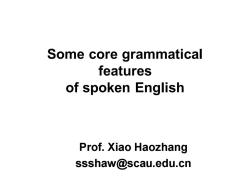
Some core grammatical features of spoken English Prof.Xiao Haozhang ssshaw@scau.edu.cn
Some core grammatical features of spoken English Prof. Xiao Haozhang ssshaw@scau.edu.cn

Some of the core grammatical features of spoken English (for example,ellipsis)share a grammatical label with similar features of written language.Some of the other features (for example,heads and tails and discourse markers), however,exist on the boundaries of what is conventionally understood as a grammar of sentences, and these have different labels. Both vague language and modal expressions directly involve lexical and pragmatic features as well as grammatical features
Some of the core grammatical features of spoken English (for example, ellipsis) share a grammatical label with similar features of written language. Some of the other features (for example, heads and tails and discourse markers), however, exist on the boundaries of what is conventionally understood as a grammar of sentences, and these have different labels. Both vague language and modal expressions directly involve lexical and pragmatic features as well as grammatical features

The terminology used throughout this publication recognises this new territory and tries to capture something of the distinctive features of the grammar of speech. We now explain these distinctive features in detail, using examples from different corpora of spoken English.The headings under which they are grouped indicate the ways in which aspects of spoken grammar work together to realise the functions associated with talk
The terminology used throughout this publication recognises this new territory and tries to capture something of the distinctive features of the grammar of speech. We now explain these distinctive features in detail, using examples from different corpora of spoken English. The headings under which they are grouped indicate the ways in which aspects of spoken grammar work together to realise the functions associated with talk
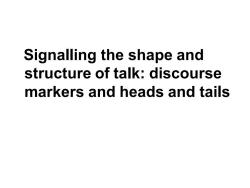
Signalling the shape and structure of talk:discourse markers and heads and tails
Signalling the shape and structure of talk: discourse markers and heads and tails

Although when we speak there are no full stops or commas or colons,we do need a kind of spoken punctuation.This helps us to organise what we say,to signpost for others what is coming up and to place what has just been said so that the listener knows how to take it.In general,signalling is a vital component of interactive communication,linking,highlighting and re-emphasising stretches of talk for our own benefit and the benefit of the listener.Features of spoken grammar that are particularly associated with signalling are discourse markers and heads and tails
Although when we speak there are no full stops or commas or colons, we do need a kind of spoken punctuation. This helps us to organise what we say, to signpost for others what is coming up and to place what has just been said so that the listener knows how to take it. In general, signalling is a vital component of interactive communication, linking, highlighting and re-emphasising stretches of talk for our own benefit and the benefit of the listener. Features of spoken grammar that are particularly associated with signalling are discourse markers and heads and tails
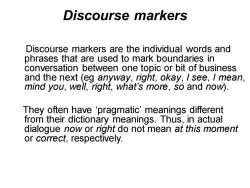
Discourse markers Discourse markers are the individual words and phrases that are used to mark boundaries in conversation between one topic or bit of business and the next (eg anyway,right,okay,I see,I mean, mind you,well,right,what's more,so and now). They often have 'pragmatic'meanings different from their dictionary meanings.Thus,in actual dialogue now or right do not mean at this moment or correct,respectively
Discourse markers Discourse markers are the individual words and phrases that are used to mark boundaries in conversation between one topic or bit of business and the next (eg anyway, right, okay, I see, I mean, mind you, well, right, what’s more, so and now). They often have ‘pragmatic’ meanings different from their dictionary meanings. Thus, in actual dialogue now or right do not mean at this moment or correct, respectively
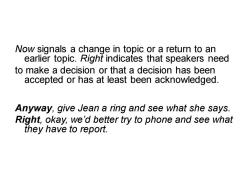
Now signals a change in topic or a return to an earlier topic.Right indicates that speakers need to make a decision or that a decision has been accepted or has at least been acknowledged. Anyway,give Jean a ring and see what she says. Right,okay,we'd better try to phone and see what they have to report
Now signals a change in topic or a return to an earlier topic. Right indicates that speakers need to make a decision or that a decision has been accepted or has at least been acknowledged. Anyway, give Jean a ring and see what she says. Right, okay, we’d better try to phone and see what they have to report
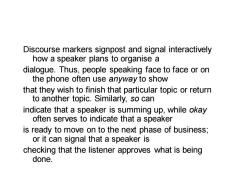
Discourse markers signpost and signal interactively how a speaker plans to organise a dialogue.Thus,people speaking face to face or on the phone often use anyway to show that they wish to finish that particular topic or return to another topic.Similarly,so can indicate that a speaker is summing up,while okay often serves to indicate that a speaker is ready to move on to the next phase of business; or it can signal that a speaker is checking that the listener approves what is being done
Discourse markers signpost and signal interactively how a speaker plans to organise a dialogue. Thus, people speaking face to face or on the phone often use anyway to show that they wish to finish that particular topic or return to another topic. Similarly, so can indicate that a speaker is summing up, while okay often serves to indicate that a speaker is ready to move on to the next phase of business; or it can signal that a speaker is checking that the listener approves what is being done

A:Mm.So did you feel that the points that you made in your original letter were all covered in this reply? B:Oh yes.I think they've answered me very well indeed
• A: Mm. So did you feel that the points that you made in your original letter were • all covered in this reply? • B: Oh yes. I think they’ve answered me very well indeed
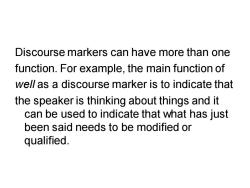
Discourse markers can have more than one function.For example,the main function of well as a discourse marker is to indicate that the speaker is thinking about things and it can be used to indicate that what has just been said needs to be modified or qualified
Discourse markers can have more than one function. For example, the main function of well as a discourse marker is to indicate that the speaker is thinking about things and it can be used to indicate that what has just been said needs to be modified or qualified
按次数下载不扣除下载券;
注册用户24小时内重复下载只扣除一次;
顺序:VIP每日次数-->可用次数-->下载券;
- 华南农业大学:《英语听说》课程教学资源(教学大纲)英语(视)听说教学大纲 Listening and Speaking.doc
- 《大学英语精读》课程教学资源(语法练习)限定词.doc
- 《大学英语精读》课程教学资源(语法练习)虚拟语气.doc
- 《大学英语精读》课程教学资源(语法练习)省略句.doc
- 《大学英语精读》课程教学资源(语法练习)形容词与副词.doc
- 《大学英语精读》课程教学资源(语法练习)名词性从句.doc
- 《大学英语精读》课程教学资源(语法练习)名词和代词.doc
- 《大学英语精读》课程教学资源(语法练习)前置词.doc
- 《大学英语精读》课程教学资源(语法练习)附加疑问句.doc
- 《大学英语精读》课程教学资源(语法练习)句子分析.doc
- 《大学英语精读》课程教学资源(语法练习)动词的时态.doc
- 《大学英语精读》课程教学资源(语法练习)动词与动词词组.doc
- 《大学英语精读》课程教学资源(语法练习)动名词.doc
- 《大学英语精读》课程教学资源(语法练习)定语从句.doc
- 《大学英语精读》课程教学资源(语法练习)倒装句.doc
- 《大学英语精读》课程教学资源(语法练习)代词.doc
- 《大学英语精读》课程教学资源(语法练习)That.doc
- 《大学英语精读》课程教学资源(语法练习)It.doc
- 《大学英语精读》课程教学资源(语法练习)As.doc
- 《大学英语精读》课程教学资源(学习资料)名词.pdf
- 《英语听说》课程教学资源(参考资料)词块表(2012)A phrsal expressions list.doc
- 《英语听说》课程教学资源(参考资料)Alignment and task success in spoken dialogue(2014).pdf
- 《英语听说》课程教学资源(参考资料)Ecological perspectives on foreign language education.pdf
- 《英语听说》课程教学资源(参考资料)L2 Listening in China - An Examination of Current Practice.pdf
- 《现代电子技术工程设计与实践》课程教学资源(实习实验)Multisim 10电路设计实例(PPT讲稿).ppt
- 《雅思高级培训》课程教学大纲.pdf
- 《大学英语》课程教学资源(PPT课件)Discovering Yourself - Catching Crabs.ppt
- 《大学英语》课程教学资源(PPT课件)DChildhood Memories.ppt
- 《大学英语》课程教学资源(PPT课件)DSocial Prejudice & Diversity - Dinner-at-Joannes.ppt
- 《大学英语》课程教学资源(PPT课件)DTales Ancient Modern.ppt
- 《大学英语》课程教学资源(学习资料)大学英语四六级写作推荐句型.pdf
- 《大学英语》课程教学资源(学习资料)四六级写作分主题备考——七大写作话题的热门词汇和句式.pdf
- 《大学英语》课程教学资源(学习资料)四六级英语词汇构词法——派生法(前缀+词根、词根+后缀).doc
- 石河子大学:《视听说》课程教学资源(第三册)视听说视听说教案(任课教师:李蕾).doc
- 石河子大学:《视听说》课程教学资源(教学大纲)语音课程教学大纲 Phonetic.doc
- 石河子大学:《视听说》课程教学资源(第一册)视听说教案.doc
- 石河子大学:《视听说》课程教学资源(第二册)视听说教案.doc
- 石河子大学:《视听说》课程教学资源(第三册)视听说教案.doc
- 石河子大学:《视听说》课程教学资源(第四册)听力教案.doc
- 石河子大学:《视听说》课程教学资源(教案讲义)语音教案.doc
